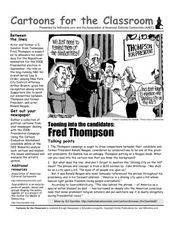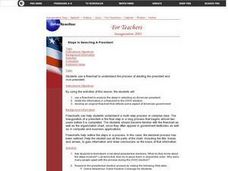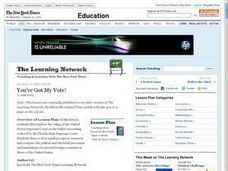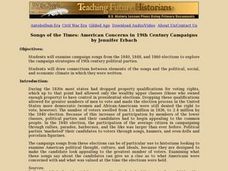Curated OER
Magnetic Polls
Students explore the New Hampshire primaries and the polling process by analyzing polling information, examining the effects of polls, and creating graphs that represent polling data.
Curated OER
Campaign 2004: Classroom Electorate
Young scholars role play as political analysts first forecasting the electoral college vote in a presidential election and then, following the results of the actual count. They study the role of swing states, and why political...
Curated OER
The U.S. Recognition of the State of Israel
Students research the political aspects of the U.S. position in the Middle East, considering, for example, Truman's position in view of the 1948 presidential election. They examine a telegram sent by the Secretary of State, George C....
Curated OER
My Country, My Country: To Vote or Not to Vote
Students view a film about elections in Iraq. They examine the story of a doctor and his decisions to vote. They work together to complete a worksheet about voter turnout.
Curated OER
Cartoons for the Classroom: Tooning into the Candidates - Fred Thompson
In this current events worksheet, students analyze a political cartoon about about 2008 presidential candidate Fred Thompson. Students then respond to 2 short answer questions.
Curated OER
Progression of Political Movements
Students examine the various political parties throughout history. In groups, they are given documents identifying the platforms of the parties in the 1868 election. To end the lesson plan, they share their information with the class...
Curated OER
Steps In Selecting A President
Learners follow a flowchart that describes the process of electing the American president and vice-president. They create a flowchart that explains some aspect of the US government.
Curated OER
You've Got My Vote!
Students explore the ruling of the US Supreme Court on the ballot recounting ordered by the Florida State Supreme Court. They work in small groups to research and compare the judicial and electoral processes.
Curated OER
Civil War and Reconstruction
Fourth graders investigate the Civil War by researching the state of Virginia. In this US History lesson, 4th graders identify Abraham Lincoln, James Chestnut and Fort Sumter, and discuss their roles in the start of the Civil War. ...
Curated OER
Presidential Race
Students explain the way in which a candidate wins an electorial race and the number of votes necessary to win in the electoral college through movement.
Curated OER
California Primary 2000
Students explore the open primary system and the candidates that appeared on the ballot in California's Presidential Primary in 2000. A variety of issues and sites are explored and form the focus of this instructional activity.
Curated OER
Songs of the Times: American Concerns in 19th Century Campaigns
Students examine campaign songs from the 1840, 1848, and 1860 elections to explore the campaign strategies of 19th century political parties.
Curated OER
The Brief American Pageant: The Politics of Boom and Bust
Prior to 1929, the Roaring Twenties were a great time to be alive and to spend money. These slides would be a good transition into a unit on the Great Depression. It presents five images about the political and financial context of the...
Curated OER
The Brief American Pageant: The Furnace of the Civil War
The eyes of an American History teacher (or Civil War buff) will open wide with this series of maps, which detail the campaigns and battles of the Civil War. Meant to supplement chapter 21 of The American Pageant, this presentation would...
Curated OER
The Brief American Pageant: The Great West and the Agriculture Revolution
What comes to mind when you think of the 1860's - other than the Civil War? Paired with The American Pageant textbook (or not), this series of images completes a lecture on the mid-19th century. Cattle trails, Indian wars, and explosions...
Illustrative Mathematics
Electoral College
A cross-curricular resource that takes the electoral votes and allows your learners to organize and analyze the data. Young voters can determine which states are more influential and interpret the dotplot provided for more data....
ProCon
President Ronald Reagan
At 69 years old, Ronald Reagan was the oldest man ever to be elected president in the United States. After reviewing a thorough history of Reagan's presidency, pupils read the main pro and con arguments to determine if he was a good...
Curated OER
The U.S. Constitution: Practical Application of the Amendments
Students create their own HyperStudio cards which include scanned images of at least one member (designated reader) of each group. They add the text of a predetermined amendment. The designated reader then reads the selected amendment.
DocsTeach
How Effective were the Efforts of the Freedmen’s Bureau?
Effective or ineffective? As part of a study of post Civil War America, young historians analyze a series of primary sources to evaluate the effectiveness of the Freedmen's Bureau in addressing the challenges faced by the slaves freed by...
Curated OER
Having Fun with Primary Sources
High schoolers analyze primary sources to determine the effects of the Great Depression on American society. They evaluate how government expanded during this time period because of New Deal legislation.
Curated OER
Death and Taxes
Students explore the "death tax" and analyze statistical information about how the government taxes dead people. They research sources to determine the validity of a anti-tax group campaign and John McCain's claims about taxes. ...
Curated OER
History by Heroes
Students role play one of the Presidents between 1877 and today. Individually, they use the internet to research the President through official documents, political cartoons and various editorials. Throughout the year, they are asked to...
Curated OER
Government Lesson Plans
Students can learn how their government is organized through these engaging lesson plans.
Curated OER
Breaking News English: Bolivian Leader to Halve Own Salary
For this English worksheet, students read "Bolivian Leader to Halve Own Salary," and then respond to 47 fill in the blank, 7 short answer, 20 matching, and 8 true or false questions about the selection.

























